
Formica is a genus of ants of the family Formicidae, including species commonly known as wood ants, mound ants, thatching ants, and field ants. Formica is the type genus of the Formicidae, and of the subfamily Formicinae. The type species of genus Formica is the European red wood ant Formica rufa. Ants of this genus tend to be between 4 and 8 mm long. Ants belonging to the Formica genus possess a single knob or bump located between their thorax and abdomen. These ants primarily feed on honeydew, a sugary liquid produced by aphids. Formica ants appear to take on a shepherding role with smaller aphids, relocating them to different parts of plants to ensure a continuous food source for the aphids. By doing so, the ants can establish a relatively sustainable honeydew supply for both themselves and their colony.
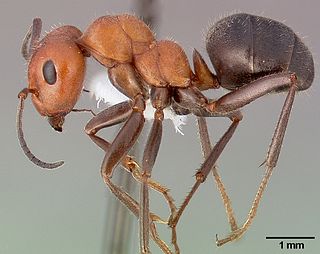
Formica obscuripes, the western thatching ant, is a species of ant in the family Formicidae. It is native to North America. It produces large mounds covered by small pieces of plant material. The number of adult workers per colony may be as high as 40,000. F. obscuripes feeds upon a number of insect species, consumes nectar from homopterous insects they tend, and occasionally eats plant tissue.
Nomada verecunda is a species in the family Apidae, in the order Hymenoptera . Nomada verecunda is found in North America.
Centris cockerelli is a species in the family Apidae, in the order Hymenoptera . The distribution range of Centris cockerelli includes Central America and North America.

Hoplitis anthocopoides is a species in the family Megachilidae, in the order Hymenoptera . The distribution range of Hoplitis anthocopoides includes Africa, Europe, Northern Asia, and North America.

Colletes simulans is a species in the family Colletidae, in the order Hymenoptera. The species is known generally as the spine-shouldered cellophane bee. It is found in North America.

Formica creightoni is a species of ant in the genus Formica, in the family Formicidae ("ants").
Stictiella formosa is a species in the order Hymenoptera, in the class Insecta ("insects"). The distribution range of Stictiella formosa includes Central America and North America.

Formica fossaceps is a species of ant in the genus Formica, in the family Formicidae. This species is a member of the Formica rufa species group.
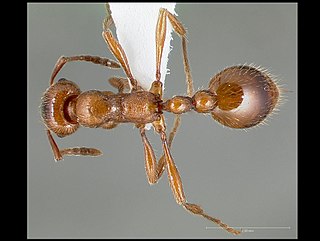
Manica hunteri is a species of ant in the family Formicidae.
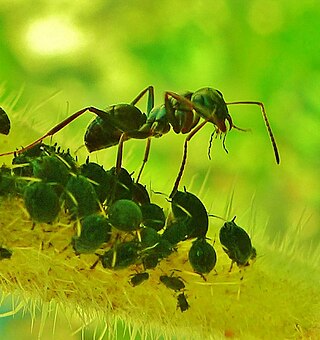
Formica glacialis is a species of ant in the family Formicidae.
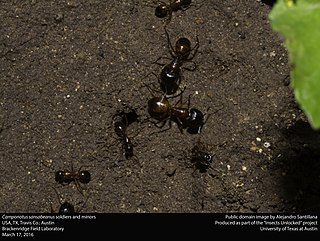
Camponotus sansabeanus is a species of ant in the family Formicidae.
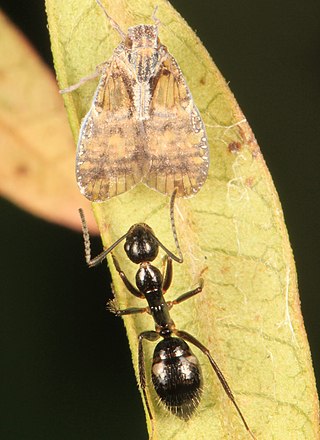
Camponotus sexguttatus is a species of ant in the family Formicidae.

Pheidole metallescens is an ant, a species of higher myrmicine in the family Formicidae.

Trachymyrmex nogalensis is a species of higher myrmicine in the family Formicidae.

Camponotus quercicola is a species of ant in the family Formicidae that is endemic to California and commonly nests in oak trees, as they usually inhabit oak forests.
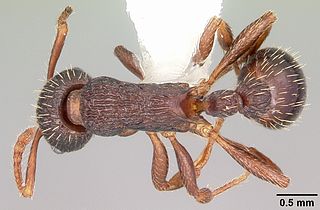
Myrmica spatulata is a species of ant in the family Formicidae. It is found in the forests of the middle and eastern part of the United States.
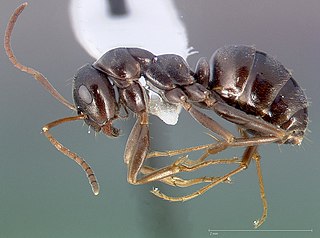
Formica microphthalma is a species of ant in the family Formicidae.

Myrmelachistini is a tribe of ants in the family Formicidae. There are at least 2 genera and 50 described species in Myrmelachistini.

Pogonomyrmex subdentatus is a species of ant in the family Formicidae.

















